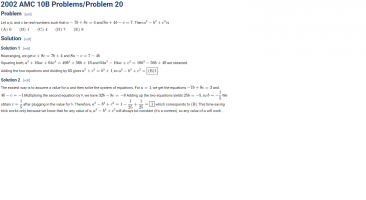Hi,
This is an AMC 10 problem. I understand the first solution, however, I got a hard time understanding the second solution approach. I do not understand why you can just assume any number in "a" and can get the answer. What is the constraint using this assumption? and how can I see this in other similar question like that. and why when the answer is constant, we can assume this trick works.
Thanks
This is an AMC 10 problem. I understand the first solution, however, I got a hard time understanding the second solution approach. I do not understand why you can just assume any number in "a" and can get the answer. What is the constraint using this assumption? and how can I see this in other similar question like that. and why when the answer is constant, we can assume this trick works.
Thanks

